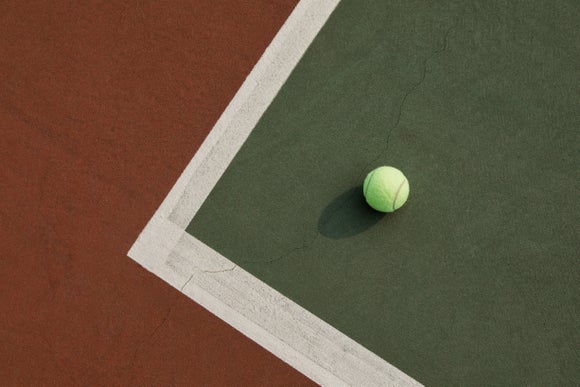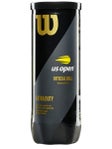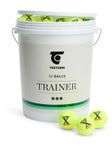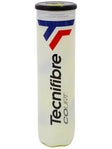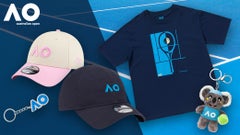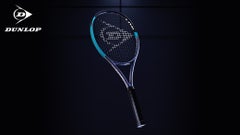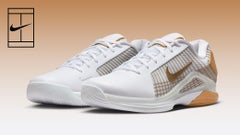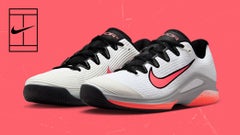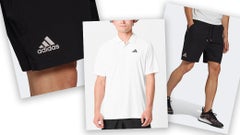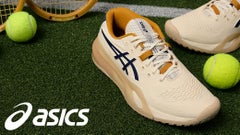Choosing the Right Tennis Ball
Although all tennis balls may seem the same, there are some differentiating factors to consider. Picking the right type of tennis ball for your surface, game and preferences could make a huge difference. All tennis balls have that same amazing smell that we all know, so what's the difference between regular duty, extra duty and premium versus champion? Let us explain!
In general, tennis balls are made with a rubber core and covered in felt, which can be made of wool or synthetic materials. Most balls are also filled with compressed air and sold in pressurized cans. But despite the same basic construction, not all tennis balls are the same. Whenever (and wherever) you step on court, having the right tennis balls for the surface and location you’re playing in will help optimize your playing experience. Below we break down the different types of balls and what separates premium balls from the value options.
Tennis Balls by Type
| Type | Best for: |
| Extra Duty | Hard courts |
| Regular Duty | Slower courts (clay) |
| Pressureless | Practice/ball machines |
| High Altitude | Elevations above 4,000 feet |
| Junior Foam Balls | Ages 3-5 |
| Junior Red Balls | Ages 6-8 |
| Junior Orange Balls | Ages 9-10 |
| Junior Green Dot Balls | Ages 11-13 |
Premium vs Value
Like with most things, tennis balls come at a variety of price levels. Here's a quick look at what the differences are. To get into the real nitty gritty keep on reading!
| Tier | Characteristics | Examples |
| Premium |
More natural wool and woven felt equals better durability, resiliency, consistency |
- Wilson US Open |
| Championship | More synthetic fibers and less natural wool made with a needle-punch construction |
- Penn Championship |
| Entry level | Made mostly of synthetic fibers and a needle-punch construction |
- Prince Pressureless Tennis Balls |
Extra Duty Balls
Extra duty balls are designed for hard surfaces such as asphalt, concrete and other outdoor hard courts. Generally, extra duty balls are more durable because of their thick felt. The extra felt will mean that the ball will last longer on these demanding surfaces. Extra duty balls will have a longer lifetime, but they will not play as fast as regular duty balls. The felt on extra duty balls opens up or "fluffs up" earlier, which allows the felt to last longer but also helps balance out the fast speed of most hard courts. These balls are pressurized and will lose their bounce over time. When shopping for extra duty balls, you may see them referred to as simply "XD" balls.
Regular Duty Balls
Regular duty balls are best for slower, softer courts, like clay, and are constructed with less felt than an extra duty ball. The idea is that the clay court will absorb more of the impact of the ball, so regular duty balls require less felt. The felt on a regular duty ball is also designed to remain compact for a longer duration, which helps speed the ball up, balancing out the slower court surface. These balls are also suitable for use on indoor courts, and although regular duty balls can be used on outdoor hard courts, they will not be as durable as extra duty balls. Regular duty balls are also pressurized and will lose their bounce over time. When shopping for regular duty balls, you may see them referred to as simply "RD" balls.
Pressureless Balls
Pressureless balls are often preferred by beginners, recreational players or as a training tool because they last longer than regular pressurized balls. Instead of being filled with compressed air, pressureless balls have thicker walls on the core, which gives them a unique sound at impact. These balls also retain their bounce over time, and therefore have a longer lifespan than a pressurized ball. This allows you to reduce the number of cans you need to open if just getting out for a practice or casual hit. Something to be mindful of is that pressureless tennis balls are heavier and harder than pressurized balls, which means that they will impact the racquet with more force. The heavier force on the racquet means that these balls will not be as arm friendly as their pressurized counterparts. These balls are not typically used in competition.
High Altitude Balls
High altitude tennis balls are designed to be used at altitudes above 4,000 feet. As a result of the thinner air, and the pressure difference between the inside of the ball and the air surrounding it, balls generally fly much faster and bounce higher. To counteract the effects of high altitude, these balls are less pressurized or are pressureless to help bring you a more normal ball bounce and playing experience.
Junior Balls
Just like picking the right tennis racquet or shoe, using the right tennis ball will have a big impact in helping a child’s tennis skill development. The categories these balls fall into are all based on hand-eye coordination level and age.
Foam Balls are designed mainly for ages 3-5, as these are the largest and slowest in their category. Red Balls mean a bit firmer feel (more pressure inside) and slightly smaller size compared to foam balls. Orange Balls, which are designed for ages 9-10, have even more pressure in the ball, and the circumference will be smaller as well. Green Balls will be the last step for junior balls, as these will be the closest to the regular “adult” balls. Green balls are designed for players aged 11-13.
LEARN MORE: Junior Gear Guide
Listen in: All About Tennis Balls
Composition of a Tennis Ball – Why it Matters
When looking deeper into the parts that make up a tennis ball, there are three main components: felt (the yellow fuzz), core (rubber) and air or gas (pressurisation). (Image below: Rolls of tennis ball felt. Courtesy of Head/Penn)
The Felt (Yellow Fuzzy Stuff)
The felt is a key component in how the ball performs. The material used and the way it is constructed are key factors that separate a premium ball from an entry-level or budget ball. Most of the balls on the market (majority of the ones sold at Tennis Warehouse) have a blend of natural wool and synthetic nylon fibres to comprise the optic yellow felt on the outer surface of the ball.
The premium balls on the market, such as the Dunlop ATP, Pro Penn Marathon, Wilson US Open and Tecnifibre Court, all have a higher concentration of natural wool fibers. Premium balls are almost always made with a woven construction; similar to how a premium rug is made from weaving the materials together. (Images below: Examples of premium Dunlop and Tecnifibre balls. Courtesy of Dunlop and Tecnifibre.)

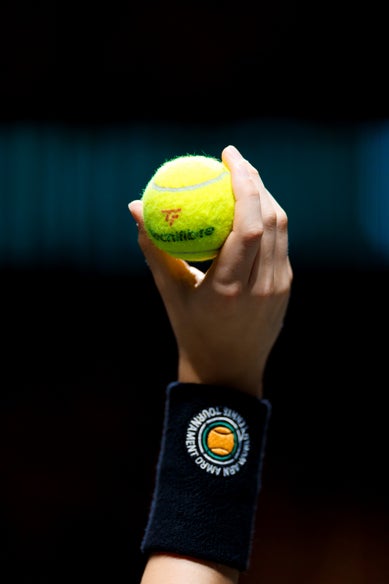
Of the balls that we sell at a lower price-point, such as the Championship (or champ) line of balls, you will typically find one of two things that varies from the premium balls. There are more nylon fibers in the felt and/or the construction is done by “needle-punch” instead of the woven application used on the premium balls.
Any balls below the Championship line of balls will be made of mostly or all with synthetic nylon fibers and will be a needle-punch felt. For those seeking a vegan-friendly ball, you can sometimes find that the entry level balls have a full synthetic nylon felt without any natural wool content. Of the balls that we carry, the pressureless balls will be made of synthetic fibers for the felt. Although these balls may be fully synthetic, the performance is typically poor in comparison to a Champion line ball and especially the premium balls. They also have a heavier, firm feel to them due to a thicker core construction and can create more shock on the player’s arms and the racquet. (Image below: Felt being cut out. Courtesy of Head/Penn)
The Core (rubber material beneath the felt)
For the majority of tennis balls, the core is made of either natural or synthetic rubber, which is pressed by steel rollers to thin it out, then heated and cut into biscuit-like forms called slugs. These slugs are then shaped and moulded to form a half sphere. Next they are cured, sanded on the rims, and then the two half-spheres are connected with adhesive to form the ball. (Image below: Tennis ball cores. Courtesy of Head/Penn)
During this process the ball is filled with compressed air. The combination of the rubber core and pressurised air gives fresh tennis balls that nice “pop” sound when they strike your strings (well hopefully strings and not your frame)! For the premium balls, and pretty much all of the balls that Tennis Warehouse sells, the core is formed from natural rubber that is derived from rubber trees and is often sourced from locations such as Thailand.
Dunlop has been in the rubber industry for many years, going back to 1926 with its origin in tires. Tecnifibre partners with Bridgestone Tires and uses premium natural rubber to make the cores for its balls. Penn sources its rubber from a specific region and find it an ideal natural rubber source for the formation and molding of tennis balls.
The Air or Gas (pressurization)
All of the premium balls and Championship line balls that Tennis Warehouse sells are typically pressurised with natural air. Tecnifibre explained that it uses the natural air composition when pressurising its tennis balls, (78 percent nitrogen, 21 percent oxygen and the remaining 1 percent is a combination of argon, carbon dioxide and trace amounts of other gases). According to Tecnifibre's testing, nitrogen is less likely to permeate through the core of the ball. Tecnifibre has tried pressurizing balls with higher concentrations of nitrogen, even all nitrogen, but through playtesting found the performance and durability differences to be negligible.
There isn't a clear standard for how much pressure is used when filling the core with air, but in one case it was noted that there was an initial PSI of 18, and as the core was cured and sealed, it settled to 15 PSI, which was the target spec. Most tennis balls are between 12 and 14 PSI. (Image below: Penn Championship balls being packaged into a case. Courtesy of Head/Penn)
So what does all this mean about the performance of the ball?
Premium balls are made of a higher concentration of natural wool, which is more durable and provides a plusher feel when striking the ball. The natural fibers last longer and maintain the fluff of the felt better for more resiliency. Premium balls also have a thicker, woven felt, which increases durability, provides a better feel on contact and a more consistent bounce. The thicker felt correlates to a stronger, sturdier seam that joins the two pieces of felt together on a ball. The natural rubber core in premium balls provides the best consistency in the bounce and speed. As with the natural wool felt, the natural rubber has the best resiliency, which results in longer playability and maintains that “pop” sound better over time. Lastly, the premium natural rubber cores contain the air pressure for longer, compared to synthetic types of rubber.
